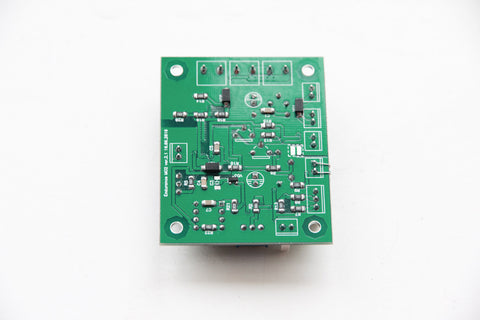
An Endurance Laser box ver 2.0 modified version


Key features of an Endurance MO2 PCB:
1. Analog input 0-10 PWM output 0-100%.
2. TTL input up to 24V PWM output.
3. Focusing mode laser PWM 0.1%.
4. Adjustable laser voltage threshold of 4.5 to 5.5V
5. Protection against reverse polarity reversal of analog, comparator and TTL inputs.
6. The delay in applying the voltage to the laser when the unit is turned on 1.5 sec.
7. Ability to install both large and small box without modifications of the printed circuit board.
8. Ability to run an impulse mode with a wide variety of frequency and duration width.




CN1 – Power Board +12V
CN2 – Analog Input/Inverted input
CN3 – Mode select switch SW1
CN4 – PWM Input
CN5 – Fan
CN6 – Input Voltage Voltmeter
CN7 – DC-DC output voltage voltmeter
XT1 – DC-DC
XT2 – Laser
XT3 – Laser current measurement. Ammeter




Control unit specifications
Load voltage:1.2V
Load currenе: 6A
Control: PWM signal
Voltage: 3-24V
Frequency: 90Hz-50kHz
Working cycle: 0-99.9%
Output signal to load: PWM
Frequency: Same as PWM input
Working cycle: Similar to PWM input signal
analog signal: Voltage 0-10V
Output signal to load: PWM
Frequency: 500Hz
Working cycle: 0-99.9%
Full power mode
Output signal to load: PWM
Frequency: 500Hz
Working cycle: 99.9%
Energy consumption: DC 12V 5A
Current stabilizer module cooling system
Cooling type: Peltier element
Temperature control: Thermal relay
Energy consumption: DC 12V 5A
The following control elements are located on the control unit:
Voltmeter – shows the input voltage.
Thermometer.
Voltammeter – shows the output voltage and current.
Controls:
Two-position button – is responsible for turning on / off the control unit.
Key switch – connected in series with the shutdown button and is an additional safety measure against accidental activation of the control unit.
The three-position button is responsible for switching the operating modes of the control unit:
Position “I” – Mode “Full power”. In this mode, the laser diode is constantly on at full power and is not controlled in any way.
Position “0” – Mode “PWM”. In this mode, the laser diode is controlled by a PWM control signal.
Position “II” – Mode “Analog”. In this mode, the laser diode is controlled by an analog signal.
The output signal from the control unit to the laser diode is a PWM signal with a frequency and duty cycle corresponding to the PWM control signal in the case of the “PWM” mode.
In “Analog” mode, the signal frequency is 500Hz and the duty cycle depends on the voltage of the analog control signal.
In “Full power” mode, the signal frequency is 500Hz and the duty cycle is 99.9%.
There is also a mode that is used to focus the laser. It is similar to “Full power” mode with the only difference being that the PWM output signal duty cycle is 0.1%. This mode is activated as follows: with the control unit turned off, you need to set the three-position button to position “I” and only then turn on the control unit. The mode will be enabled until the three-position button is switched to another position.
There is a thermal relay on the cooling unit of the current stabilizer, which sets the temperature for turning on the cooling system (Peltier element) so that the stabilizer does not overcool to the state of condensate. The upper temperature indicator on the thermal relay is the current temperature on the temperature sensor, the lower temperature indicator is the set temperature, when it is exceeded by one degree, cooling will turn on (if the temperature is lower, then cooling will turn off). The temperature is set by pressing the upper button on the thermostat, after which the lower temperature indicator will flash. The upper and lower buttons set a higher or lower temperature. If, when setting the temperature, the buttons are not pressed for 2-3 seconds, the set temperature is saved in the settings.










